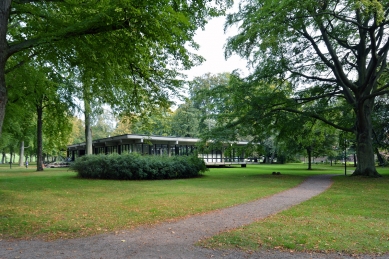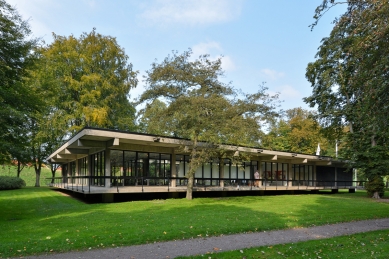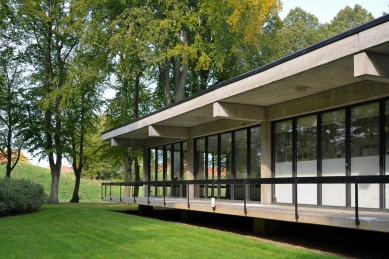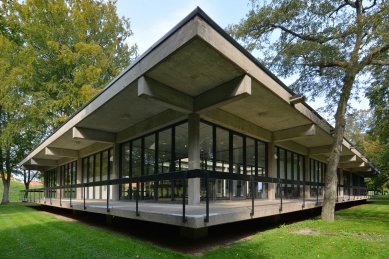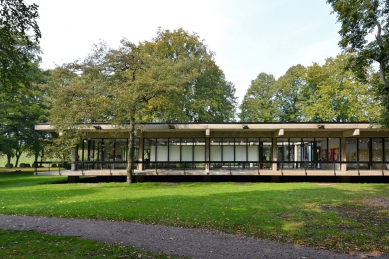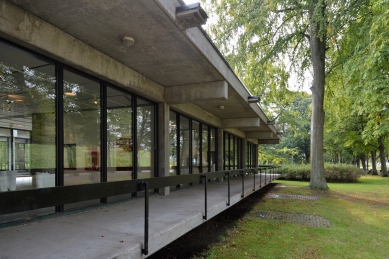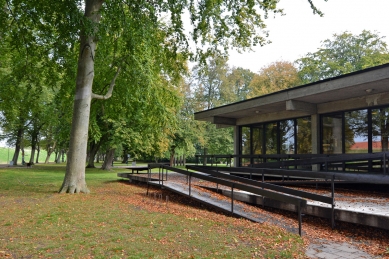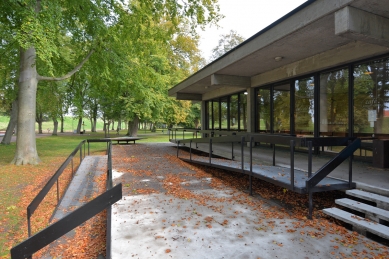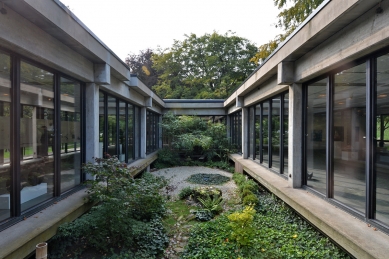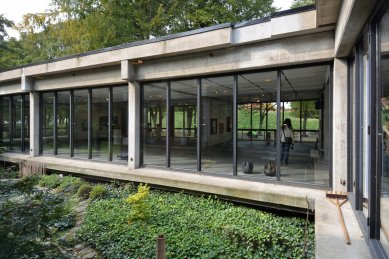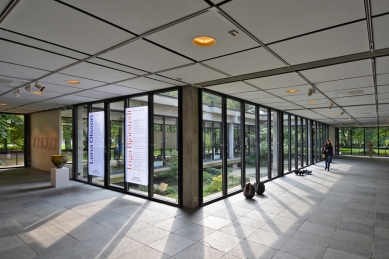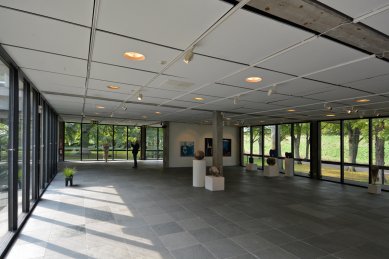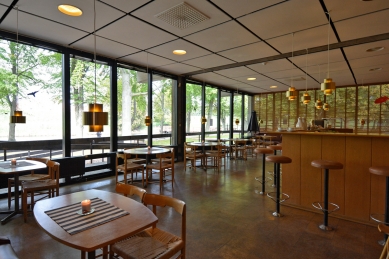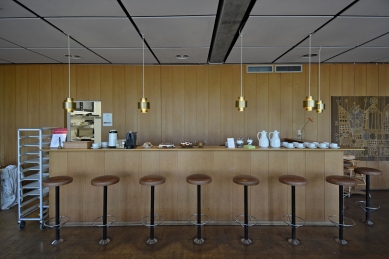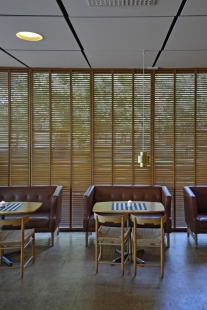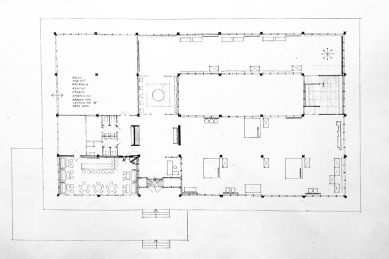
Landskrona Art Gallery
Landskrona konsthall

View, interrupted.
The word horizon has been accorded a special place in the concept of modernism. Something spiritual and at the same time promisingly endless. The literal meaning lies close to the original greek horiein (limiting). Horizon defines the limit of the domain that can be seen. The boundary where heaven and earth/ ocean seem to meet. Horizon as a concept is frequently brought forth when metaphysical perspectives shift throughout the history of ideas. When the horizon of modernism sweepingly stretched in several directions, new metaphorical images arose: the change between night and day became a social metaphor where above all the sunrise on the horizon represented the growth of the new, enlightened society. The horizon also became the goal for long, penetrating vistas, or placed seductive barriers in their proper context. Within its nature of limitation, the horizon forms a backdrop against which everything takes place in an inevitable context.
The artists Patrik Aarnivaara and Jakob Simonson have chosen to call their exhibition in Landskrona Konsthall Synrand, preferring a synonym to the more-obvious ”horizon”. They describe how they came upon the almost forgotten word when they tried conceptualizing their installation at the art center, where window sections with applied mirror foil underscore the differences between the eye-levels of different viewers. Aarnivaara and Simonson speak of how one closes one’s eyes and imagines a horizon: stripped, minimized, and at the same time optically exact. In Swedish, the word ”synrand” is etymologically seen as older and closer than the occidental, dominant ”horizon”. But in context there is also another type of closeness which can most accurately be described as subjective. Synrand presumes that there is someone who sees. As a boundary, it is the limit of sight which varies with a specific eye-level, which makes the exhibition title unusually relevant. Even if the idea of horizon, technically speaking, also varies from different points-of-view, a generalized metaphor tends to reduce horizon to being a fixed given for existence. Differences in seeing have instead come to belong to the pictorial language of perspective.
Landskrona Konsthall is, in two senses, a horizontal building. Its appearance can be described as two large horizontal platforms, floor and roof, borne by a system of plinths and columns. Between the platforms are wall units which separate the building’s different rooms. The large characteristic areas of glass form transparent outside walls, as well as defining a small atrium garden, which also can be seen as a vertical, rectangular hole punched through the body of the building. The architectural concept of the building, with large wall areas of glass and strict system of columns, belongs to the typical modernistic genre. When Landskrona Konsthall opened in 1963, the modernist ideal had been implemented in a growing number of buildings in the previous decades. The architects Sten Samuelsson and Fritz Jaenecke had certainly been influenced by such buildings as Farnsworth House (1951, Chicago, Illinois), drawn by Ludwig Mies van der Rohe or Philip Johnson’s Glass House (1949, New Canaan Connecticut).
Landskrona Konsthall has often been described as a good example of Swedish modernism and is said to be appreciated by the public at large. It is often noted how well the building suits the surrounding park. It might be an exaggeration to say that the Konsthall is camouflaged by its surroundings. Instead, it is a typical example of architecture that is regarded as neutral, adaptable and timelessly consistent. Here one is confronted with another, metaphoric, meaning of the concept ”horizontal building”. Analogous to the contrast between ”synrand” and ”horizon”, the building appears horizontal in that it offers no resistance. It is neutral towards its visitors: no resistance, no irritating demands. Instead it offers a well-proportioned framework which strengthens order and fixed perspectives, something which could be seen as an ideal condition for an exhibition space. The building’s neutrality becomes at times a paradox, as it simultaneously, despite its low-keyed nature, so strongly is perceived as a self-asserting object.
It would be easy to see Landskrona Konsthall as a beautiful, and beautifully situated, modernistic glass box. Its object-like character is reinforced by the way the building is raised slightly above ground, almost seeming to hover. Physically, it does not have much to do with the city of Landskrona. Instead it is coupled by remote control to a global modernistic network (the international style) outside its place in the park environment. The pervasive neutrality of the Konsthall has also made itself known in actual exhibition situations. There have been, for example, exhibitors experiencing problems with objects reflected in the glass areas, perhaps a negative feature in a building originally meant to show industrial design.
In the exhibition Synrand, Patrik Aarnivaara and Jakob Simonson explore the nature of Landskrona Konsthall. The mirror foil which partially covers the glassed areas is placed to correspond to different eye-levels. Seen from a concrete, spacial sense, the intervention could scarcely be less subtile; the well-proportioned rooms of the building are left untouched. The artistic intrusion is instead concentrated to the glassed areas, where almost over-democratic, accented eye-levels close off and block the larger spectra of vantage points. The result is that one can partially, according to one’s eyelevel, look out. Turning to look in another direction, one is instead reflected alongside the surrounding room. After a while, one discovers that the mirror foil is partially translucent, which, given the proper light conditions, allows the landscape outside to be glimpsed.
The exhibition also contains a model of Landskrona Konsthall constructed by Aarnivaara and Simonson. The model is placed in one of the buildings contained and less-public rooms. Just as with the exhibition in a broader sense, one can see the model as a comment on Landskrona Konsthall. Here is it above all its strong objectified nature that is remarked in the choice of visible materials, such as chip board. The model accentuates the sense of object by eliminating the building’s surrounding context. For example, the idea of the atrium as a hole is strengthened by not showing the ground in the atrium garden. Here there is no ground level at all. The model becomes a freely hovering object lacking physical connections.
This is not the first time that artists attempt to comment on Landskrona Konsthall and its architecture through their work. In a greater perspective, it is neither unique for contemporary artists to examine modernistic architecture in their work. One could almost speak of a special genre that has become more common during recent years, and which questions modernism’s architects by examining, commenting, and/or suggesting changes. It is on the other hand seldom that the word ”deconstruction” feels as pertinent and revitalized as it does with the exhibit Synrand. With subtile methods, Patrik Aarnivaara and Jakob Simonson let the art center expose itself. The thin mirror film ”remote-blocks” the building, which is not only shut off from its own horizontal qualities. During the exhibition, the building is also closed from a flow of random sense of style which otherwise views it as a modernistic exponent. Here the art center is left to itself and its own character as an object. The gaze is turned inwards, and a question becomes more imperative: how does this building actually work?
The word horizon has been accorded a special place in the concept of modernism. Something spiritual and at the same time promisingly endless. The literal meaning lies close to the original greek horiein (limiting). Horizon defines the limit of the domain that can be seen. The boundary where heaven and earth/ ocean seem to meet. Horizon as a concept is frequently brought forth when metaphysical perspectives shift throughout the history of ideas. When the horizon of modernism sweepingly stretched in several directions, new metaphorical images arose: the change between night and day became a social metaphor where above all the sunrise on the horizon represented the growth of the new, enlightened society. The horizon also became the goal for long, penetrating vistas, or placed seductive barriers in their proper context. Within its nature of limitation, the horizon forms a backdrop against which everything takes place in an inevitable context.
The artists Patrik Aarnivaara and Jakob Simonson have chosen to call their exhibition in Landskrona Konsthall Synrand, preferring a synonym to the more-obvious ”horizon”. They describe how they came upon the almost forgotten word when they tried conceptualizing their installation at the art center, where window sections with applied mirror foil underscore the differences between the eye-levels of different viewers. Aarnivaara and Simonson speak of how one closes one’s eyes and imagines a horizon: stripped, minimized, and at the same time optically exact. In Swedish, the word ”synrand” is etymologically seen as older and closer than the occidental, dominant ”horizon”. But in context there is also another type of closeness which can most accurately be described as subjective. Synrand presumes that there is someone who sees. As a boundary, it is the limit of sight which varies with a specific eye-level, which makes the exhibition title unusually relevant. Even if the idea of horizon, technically speaking, also varies from different points-of-view, a generalized metaphor tends to reduce horizon to being a fixed given for existence. Differences in seeing have instead come to belong to the pictorial language of perspective.
Landskrona Konsthall is, in two senses, a horizontal building. Its appearance can be described as two large horizontal platforms, floor and roof, borne by a system of plinths and columns. Between the platforms are wall units which separate the building’s different rooms. The large characteristic areas of glass form transparent outside walls, as well as defining a small atrium garden, which also can be seen as a vertical, rectangular hole punched through the body of the building. The architectural concept of the building, with large wall areas of glass and strict system of columns, belongs to the typical modernistic genre. When Landskrona Konsthall opened in 1963, the modernist ideal had been implemented in a growing number of buildings in the previous decades. The architects Sten Samuelsson and Fritz Jaenecke had certainly been influenced by such buildings as Farnsworth House (1951, Chicago, Illinois), drawn by Ludwig Mies van der Rohe or Philip Johnson’s Glass House (1949, New Canaan Connecticut).
Landskrona Konsthall has often been described as a good example of Swedish modernism and is said to be appreciated by the public at large. It is often noted how well the building suits the surrounding park. It might be an exaggeration to say that the Konsthall is camouflaged by its surroundings. Instead, it is a typical example of architecture that is regarded as neutral, adaptable and timelessly consistent. Here one is confronted with another, metaphoric, meaning of the concept ”horizontal building”. Analogous to the contrast between ”synrand” and ”horizon”, the building appears horizontal in that it offers no resistance. It is neutral towards its visitors: no resistance, no irritating demands. Instead it offers a well-proportioned framework which strengthens order and fixed perspectives, something which could be seen as an ideal condition for an exhibition space. The building’s neutrality becomes at times a paradox, as it simultaneously, despite its low-keyed nature, so strongly is perceived as a self-asserting object.
It would be easy to see Landskrona Konsthall as a beautiful, and beautifully situated, modernistic glass box. Its object-like character is reinforced by the way the building is raised slightly above ground, almost seeming to hover. Physically, it does not have much to do with the city of Landskrona. Instead it is coupled by remote control to a global modernistic network (the international style) outside its place in the park environment. The pervasive neutrality of the Konsthall has also made itself known in actual exhibition situations. There have been, for example, exhibitors experiencing problems with objects reflected in the glass areas, perhaps a negative feature in a building originally meant to show industrial design.
In the exhibition Synrand, Patrik Aarnivaara and Jakob Simonson explore the nature of Landskrona Konsthall. The mirror foil which partially covers the glassed areas is placed to correspond to different eye-levels. Seen from a concrete, spacial sense, the intervention could scarcely be less subtile; the well-proportioned rooms of the building are left untouched. The artistic intrusion is instead concentrated to the glassed areas, where almost over-democratic, accented eye-levels close off and block the larger spectra of vantage points. The result is that one can partially, according to one’s eyelevel, look out. Turning to look in another direction, one is instead reflected alongside the surrounding room. After a while, one discovers that the mirror foil is partially translucent, which, given the proper light conditions, allows the landscape outside to be glimpsed.
The exhibition also contains a model of Landskrona Konsthall constructed by Aarnivaara and Simonson. The model is placed in one of the buildings contained and less-public rooms. Just as with the exhibition in a broader sense, one can see the model as a comment on Landskrona Konsthall. Here is it above all its strong objectified nature that is remarked in the choice of visible materials, such as chip board. The model accentuates the sense of object by eliminating the building’s surrounding context. For example, the idea of the atrium as a hole is strengthened by not showing the ground in the atrium garden. Here there is no ground level at all. The model becomes a freely hovering object lacking physical connections.
This is not the first time that artists attempt to comment on Landskrona Konsthall and its architecture through their work. In a greater perspective, it is neither unique for contemporary artists to examine modernistic architecture in their work. One could almost speak of a special genre that has become more common during recent years, and which questions modernism’s architects by examining, commenting, and/or suggesting changes. It is on the other hand seldom that the word ”deconstruction” feels as pertinent and revitalized as it does with the exhibit Synrand. With subtile methods, Patrik Aarnivaara and Jakob Simonson let the art center expose itself. The thin mirror film ”remote-blocks” the building, which is not only shut off from its own horizontal qualities. During the exhibition, the building is also closed from a flow of random sense of style which otherwise views it as a modernistic exponent. Here the art center is left to itself and its own character as an object. The gaze is turned inwards, and a question becomes more imperative: how does this building actually work?
0 comments
add comment


